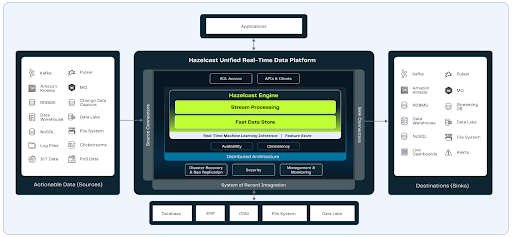How Will You Select the Right Technology for Your Streaming Data?
If you haven’t already gotten a copy of The Forrester Wave™: Streaming Data Platforms, Q4 2023 report, get your complimentary copy here. We’re honored to be included as one of the 14 streaming data platform vendors covered in the report, and we’re very excited to be named a Strong Performer in this vital technology category.
We hope this report will give you a good assessment of some of the top vendors in the market. As you evaluate streaming data platforms to help you get the most out of your streaming data, think about the areas of expertise in each vendor on your shortlist. Do you want to explore different options that only provide a different skin on the same underlying technology, or do you want to explore the different technologies as well? If you’re interested in understanding the various options in the market, that’s where Hazelcast can fit in.
You Can’t Be Better If You’re the Same
One fact about our product, Hazelcast Platform, is that our research and development team developed the core engine entirely. In other words, the core is not a re-packaging of a third-party open source technology, which is what many other vendors offer. That means our internal architecture is different from the rest of the pack, and that’s the source of our differentiation and our advantages.
When evaluating streaming data platforms, do not assume they are all alike and that they all will provide similar value. Be sure to identify the key challenges you need to solve and map them to the technology characteristics of each product you are evaluating.
Faster Responsiveness Is the Goal
You probably already have a good idea of the challenges you need to address, and we’re inclined to believe that the things you care the most about are aligned with many of the core principles we embrace when we build our technology. For example, many of our customers care about high throughput, low latency, hardware efficiency, easier development, easier maintenance, and real-time responsiveness. If your requirements align with those core principles, you should take a closer look at Hazelcast Platform.
To drill down on one of our core principles, we believe that fast responsiveness is essential for our customers to create a competitive advantage. And we’re talking about responsiveness beyond fast data access and fast data calculations (both of which we support very well, by the way). We’re also talking about capturing data about customer interactions and behaviors, enriching that data with historical context, identifying an actionable insight, and then taking action on that insight when it matters most to the customer (i.e., right now). This type of responsiveness is often labeled as “real-time.” To be clear, “real-time” should not be tightly correlated with “ultra-low latency,” but rather, should be associated with the “right time.”
We hear customers talk about real-time as seconds or even minutes. For customers who think real-time includes time windows that last several minutes or more, we challenge them to think about what business value they can get if their implementation of real-time was reduced dramatically. They then start seeing impactful opportunities they hadn’t thought of before. For example, what if a store could deliver a promotional offer to customers while shopping? What if a transportation company could identify correctable logistics challenges within seconds versus an hour later? What if a delivery company could predict the best route now versus 10 minutes later?
Innovative Streaming Data Initiatives Don’t Have to Be Hard
I’ve always believed that businesses don’t pursue data-driven, real-time initiatives that will give them a clear competitive advantage because the effort seems too difficult and costly, and not because the value is unclear. It seems too difficult and costly because businesses try to leverage their existing technologies to address real-time challenges. But their technologies weren’t built to handle today’s real-time initiatives. Even many technologies today that purportedly address real-time capabilities are still not well-suited to handle the high-value use cases that can create competitive advantage today.
Hazelcast was designed to handle real-time responsiveness, or instant action, because we’ve put a lot of focus on the processing side of IT architectures. While other platforms are storage-centric and try to deliver data as quickly as possible by giving you the most value from your storage hardware, we provide a framework for getting the most value out of your RAM and CPUs. This means we provide high throughput and low latency, leading to greater efficiency, which subsequently translates into lower hardware and maintenance costs. And if you’ve ever complained about the surprisingly high costs of deploying technologies in the cloud, you know that efficiency and price performance need to be critical factors in your choice of future technologies.
There are several architectural optimizations that Hazelcast implements that lead to our performance advantage, but the most obvious one is that we have a unified platform (a unified real-time data platform, to be exact) that combines a high-powered stream processing engine with a fast, in-memory data store, together in a single runtime. You get distributed computing and distributed in-memory storage all in a single cluster. This leads to a high level of data locality and, thus, much fewer network hops, which gives us a huge advantage over other single-function technologies that have to be bolted together and thus add network latency and overall complexity.

The key part here that many folks might overlook is that when you work with streaming data, you often need to correlate and enrich that data with historical reference data. Like when you offer a customer a promotion, you want to know their past buying habits. Or if you process a credit card purchase, you want to determine if it is valid by checking the purchase characteristics against the cardholder’s history of purchases. And if you have to look up historical data while processing a fast incoming stream of data, you want those lookups to be as fast as possible and not hindered by extra network calls. Hazelcast provides that streamlined architecture. And of course, since your developers don’t need to worry about integrating separate clusters to handle all the critical lookups, that significantly simplifies their development effort. And that leads to faster time-to-market and faster ROI.
Ask Us How We Can Help
In the previously mentioned Forrester Wave report, we are recognized for our strengths in throughput, low latency, and data enrichment, and we believe those go a long way in reducing cluster sizes to reduce complexity and create efficiencies that lead to lower hardware costs. Read more about what Forrester has to say about Hazelcast, and please include us when evaluating technologies for your next streaming data initiative. If you’re interested in learning more, please contact us to chat about your initiatives, your challenges, and how we can potentially help.



